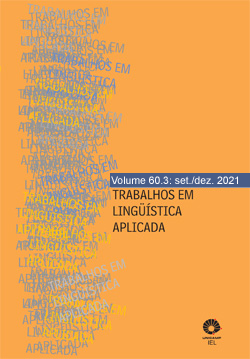Abstract
The problem that is addressed in this article is related to the difficulties observed in the use of the particle como in ELE learners of competence level A2 and B1 with French, German and English L1. To this end, a study of the Corpus of Learners in digital format (Computer Learner Corporation, CLC) is carried out. The variables correspond to the trend of use of the particle como according to the level of competence A2 and B1 and the mother tongue. From the CAELE corpus, a set of 1578 digital textual sentences of Anglo-Saxon, French-speaking and German learners of ELE has been constituted. The main objectives are (1) to determine the most frequent uses of the particle as according to the attributive uses of exemplification, relative modal and comparative and (2) to delimit the most frequent uses according to the level of competence and mother tongue of the students. learners in study. The results show greater use of the particle como a function of exemplary attribute, followed by the use of relative mode and comparative equality. Regarding the L1 and level of competence, the French-speaking learners of B1 show a greater number of uses in the structures under study, followed by the Germans of level A2 and the Anglo-Saxons of level B1.
References
ACÍN VILLA, E (2001). “Algo más sobre como”. Anuario de Estudios Filológicos, XXIV, pp. 9-24.
BELLO, A. (1988). Gramática de la lengua castellana destinada al uso de los americanos. Madrid: Arco Libro.
BRUCART, J. M. (1999). “La estructura del sintagma nominal: las oraciones de relativo”, en Bosque y Demonte (dirs.), tomo 1, pp. 395-522.
CANO AGUILAR, R. (1995). Sintaxis histórica de la comparación en español. La historia de como. Sevilla: Universidad de Sevilla.
CONSEJO DE EUROPA. (2001). Marco Común Europeo de Referencia para la Enseñanza de las lenguas. Madrid: Instituto Cervantes-MECD, Anaya.
CUADRADO, L. (2002). Sobre el funcionamiento de como en español. Revista de Filología Románica, 19, pp. 325-340.
DÍAZ RODRÍGUEZ, L.; MARTÍNEZ SÁNCHEZ, R.; REDÓ BANZO, J. (1964). Guía rápida del “Marco” para ELE: contenidos lingüísticos por niveles para el Marco Europeo de referencia para la enseñanza de las lenguas. Barcelona, ReGAE.
FERREIRA, A. (2016). “Prueba de multinivel con fines específicos académicos”. Universidad de Concepción, Chile.
FERREIRA, A. (2018-2021). FONDECYT- CONICYT N° 1180974. “Diseño e implementación de un corpus escrito de aprendientes de ELE en formato computacional para el análisis de la interlengua”. Proyecto de Investigación. CONICYT, Chile.
FERREIRA, A.; ELEJALDE, J. (2019). Hacia un perfil lingüístico-comunicativo del estudiante de Español como Lengua Extranjera para fines Académicos. Revista Nebrija De Lingüística Aplicada a La Enseñanza De Lenguas. v.13, n. 27, pp145-165.
FERREIRA, A.; BLANCO, L.; ELEJALDE, J. (2020). “Análisis de Errores en el Corpus CAELE: estudio sobre la concordancia gramatical en el verbo SER en aprendientes francófonos y anglosajones”. Revista Nebrija De Lingüística Aplicada a La Enseñanza De Lenguas. v. 14, n.29, p.76-99.
FERREIRA, A.; ELEJALDE, J. (2020). Propuesta de una taxonomía etiológica para etiquetar errores de interlengua en el contexto de un corpus escrito de aprendientes de ele”. Forma y Función. v. 33, n.1, p. 115-146.
GONZÁLEZ GARCÍA, L. (1995). “Así y como, fóricos textuales”, Moenia 1, pp. 315-329.
GRANGER, S. (2015). Contrastive interlanguage analysis: A reappraisal, International Journal of Learner Corpus Research. v.1, n1, p.7-24.
HASSELGARD, H.; JOHANSSON, S. (2011). “Learner corpora and contrastive interlanguage análisis”. In: F. Meunier, S. De Cock, G. Gilquin y M. Paquot, (eds), A taste for corpora: In honour to Sylviane Granger, 1ª ed, Amsterdam/Philadelphia: John Benjamins Publishing Company, p. 33-62.
INSTITUTO CERVANTES. (2006). Plan curricular del Instituto Cervantes. Niveles de Referencia para el español, Madrid: Instituto Cervantes- Biblioteca Nueva.
JIMÉNEZ, J. (2003). “Como en español actual”. Verba. v 30, n.1, p.117-161.
KILGARRIFF, A.; RYCHLÝ, P.; SMRŽ, P.; TUGWELL, D. (2004). The Sketch Engine. Information Technology. pp.105, 116.
KILGARRIFF, A.; BAISA, V.; BUŠTA, J.; JAKUBÍČEK, M.; KOVÁŘ, V.; MICHELFEIT, J.; RYCHLÝ, P.; SUCHOMEL, V. (2014). The Sketch Engine: Ten years on. Lexicography, 1, pp. 7-36.
MARTÍNEZ GARCÍA, J.A. (1989). El pronombre. II. Numerales, indefinidos y relativos. Madrid: Arco Libros.
MORERA, M. (1990). “El adverbio relativo como: significado y usos”, en Actas del Congreso de la Sociedad Española de Lingüística, XX Aniversario, tomo II, pp. 681-691.
REAL ACADEMIA ESPAÑOLA. (2005). Diccionario Panhispánico de dudas, 1ª ed. Madrid: Taurus.
REAL ACADEMIA ESPAÑOLA. (2010). Manual de la Nueva Gramática de la Lengua Española. Buenos Aires: Espasa.
REAL ACADEMIA ESPAÑOLA. (2014). Diccionario de la lengua española, 23ª ed.. Buenos Aires: Espasa.
SÁNCHEZ, A. (2015). La Investigación de Corpus de Aprendientes y el desarrollo de los estudios de la interlengua del español, Language design: Journal of theoretical and experimental linguistics. v.17, n.1, p. 57-83.
TRUJILLO, R. (1990). “Sobre la explicación de algunas construcciones de como”, Verba, 17, pp. 249-266.

This work is licensed under a Creative Commons Attribution 4.0 International License.
Copyright (c) 2021 Trabalhos em Linguística Aplicada


